- Good Sam Community
- Everything RV
- DIY Maintenance
- Re: Charging with TV alternator... Mod with pics.....
- Subscribe to RSS Feed
- Mark Topic as New
- Mark Topic as Read
- Float this Topic for Current User
- Bookmark
- Subscribe
- Mute
- Printer Friendly Page
Charging with TV alternator... Mod with pics...
- Mark as New
- Bookmark
- Subscribe
- Mute
- Subscribe to RSS Feed
- Permalink
- Report Inappropriate Content
Mar-22-2015 04:16 PM
I did a small charge today and checked voltages only. My clamp on amp meter was not working... I will post back with amps and how long it takes to recharge from 12 volts to fully charged...
These are the anderson like connectors I got cheap on amazon. total about $40 bucks. I had to cut the ends and solder on a 3/8" ring to connect to battery. The other side was fine. I connected the other to a 50 amp resettable breaker..
These are 6 gauge.
Also note my truck has a 105 amp alt. I want to limit the amps out why I used 50 amp breakers. Truck runs alone at about 20 amps. So it should not do more then 70 when charging.
I may change the breakers to 40 or 30 amperes...
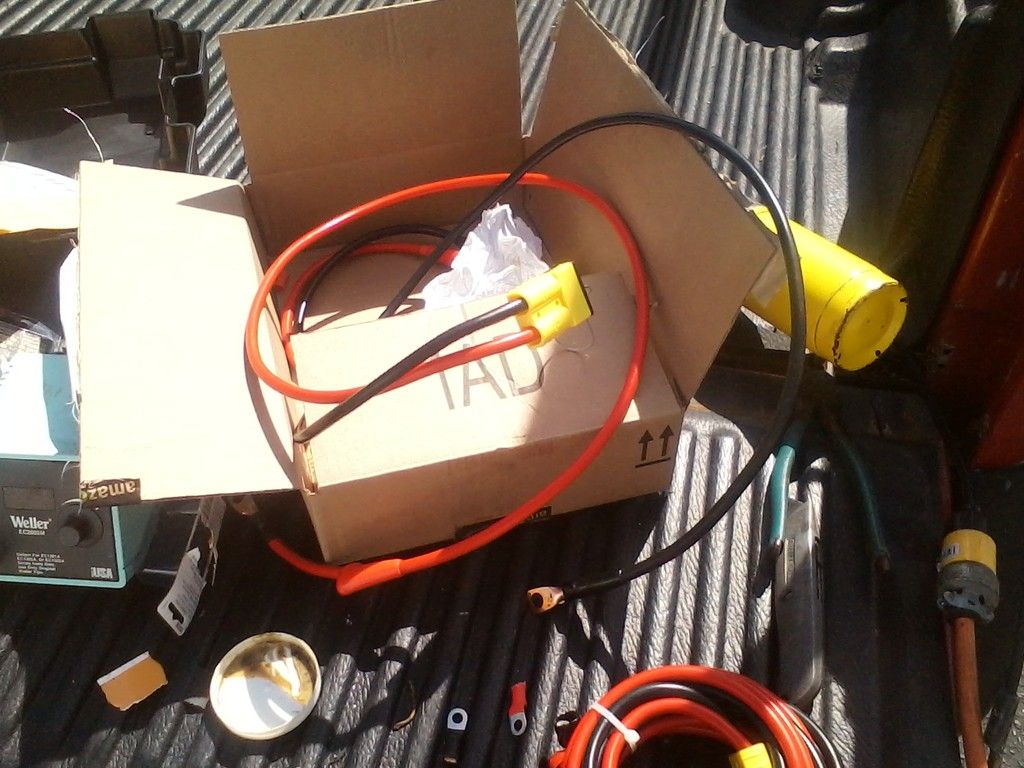
New battery studs/side mount with 3/8" extension. 50 amp breaker on pos side with bracket. Got these breakers from e trailer...
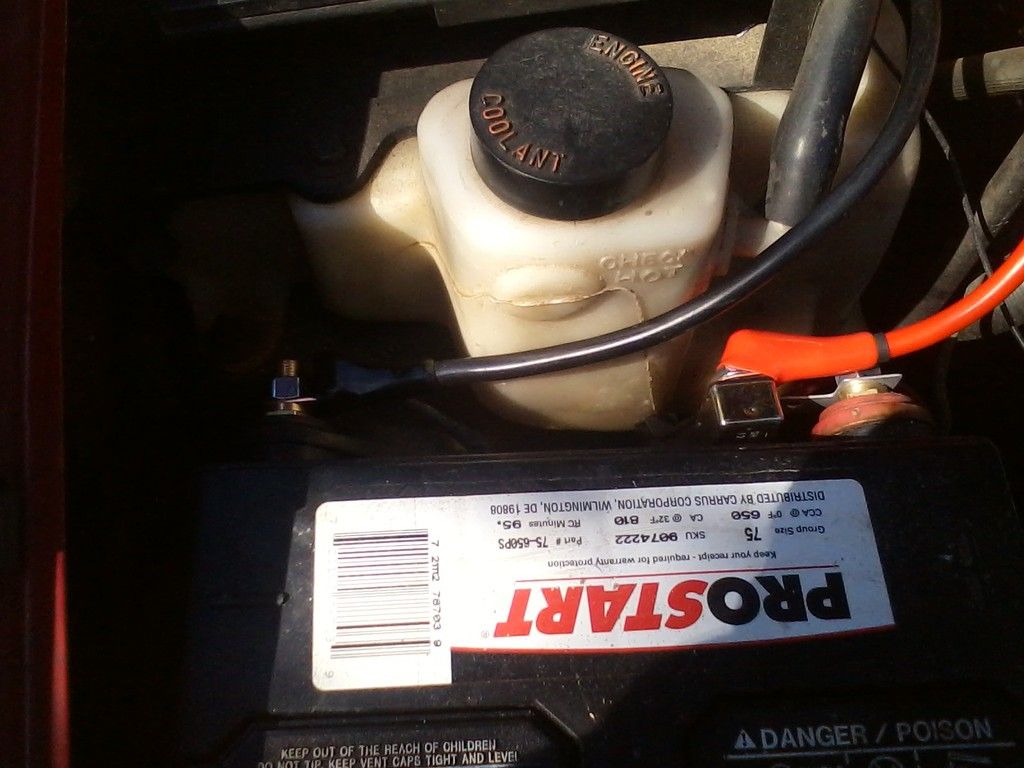
50 amp breaker with bracket.
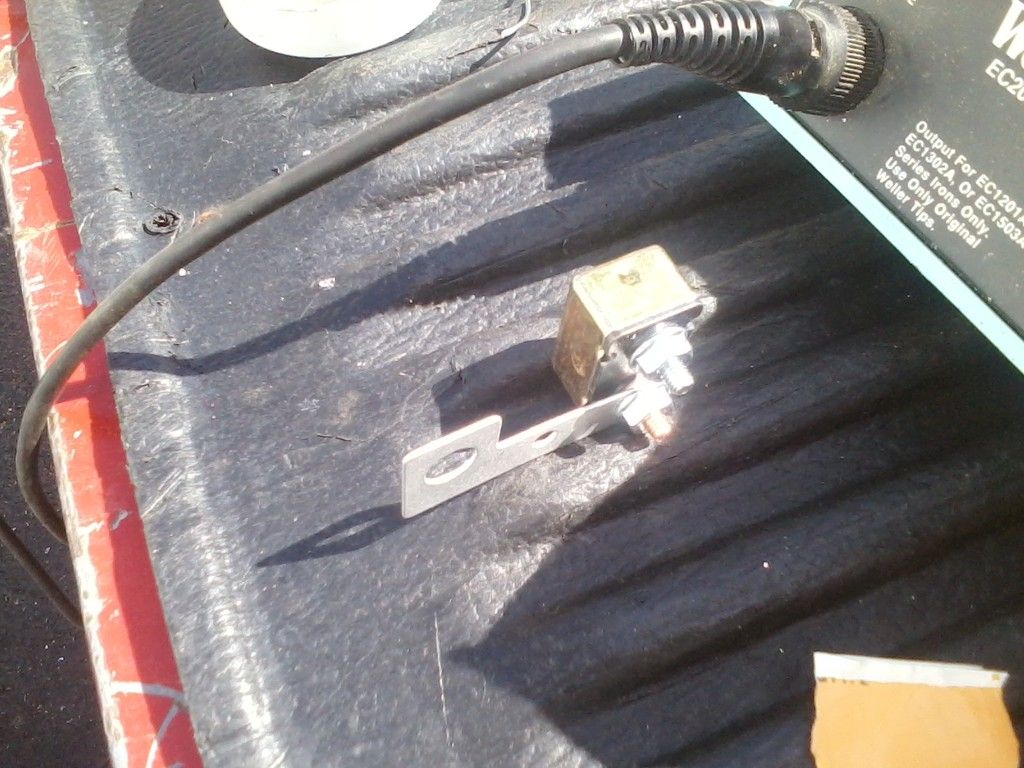
Keep it rolled up in a void near firewall..
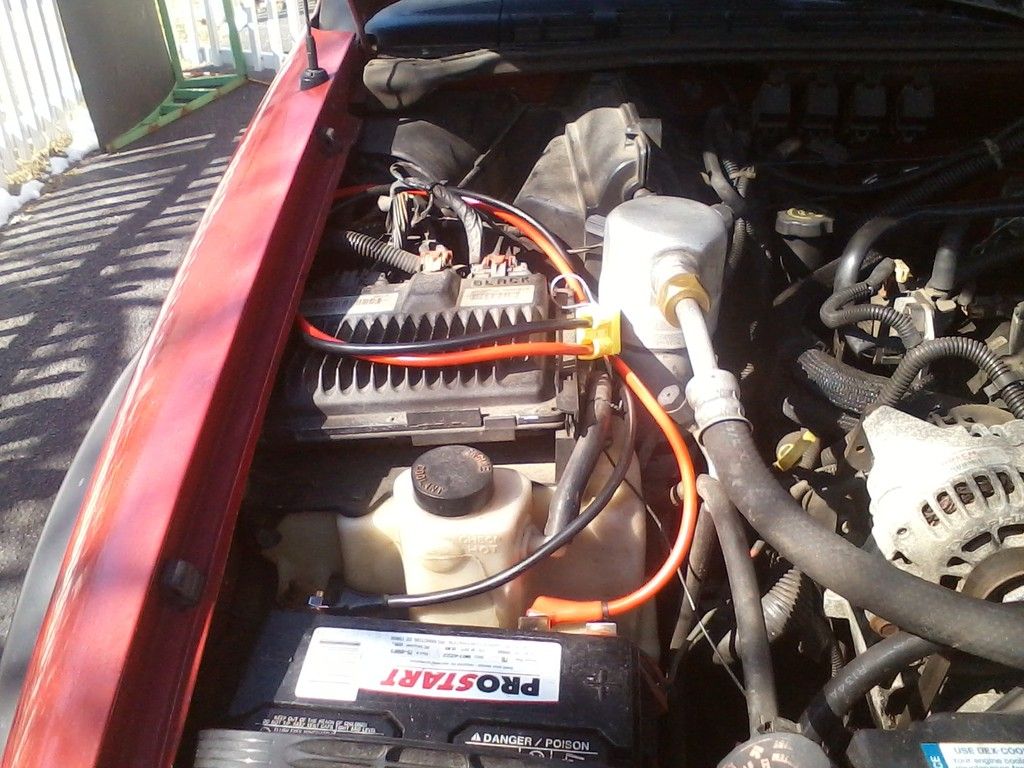
Camper side. 8ft rolls up nice and stores in left side box.. Note 50 amp breaker on this end too on pos side right batt.... Dont need no short or fires...

Connected to TV.....

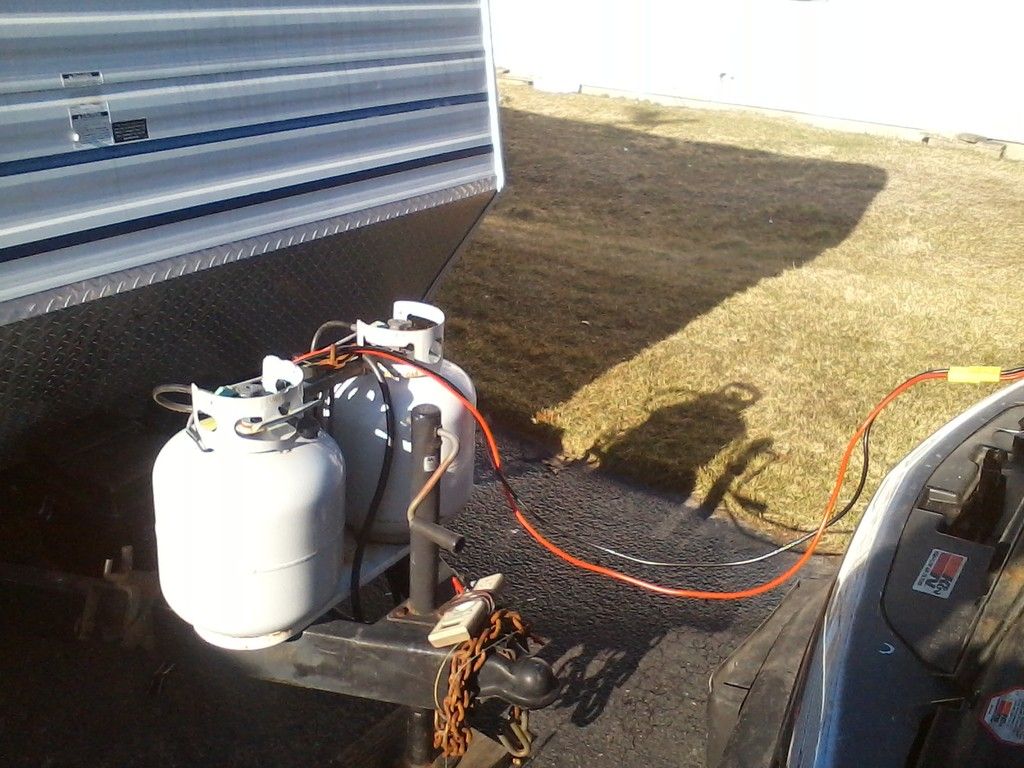
This is the voltage I am getting at my home made meter. I tied into 12v wires that are in the wall for the tank/battery monitor. so its not right from the convertor.
Notice 14.32 volts. I gave a charge when batterys were down to 12.4.
So the truck puts out over 14 volts.
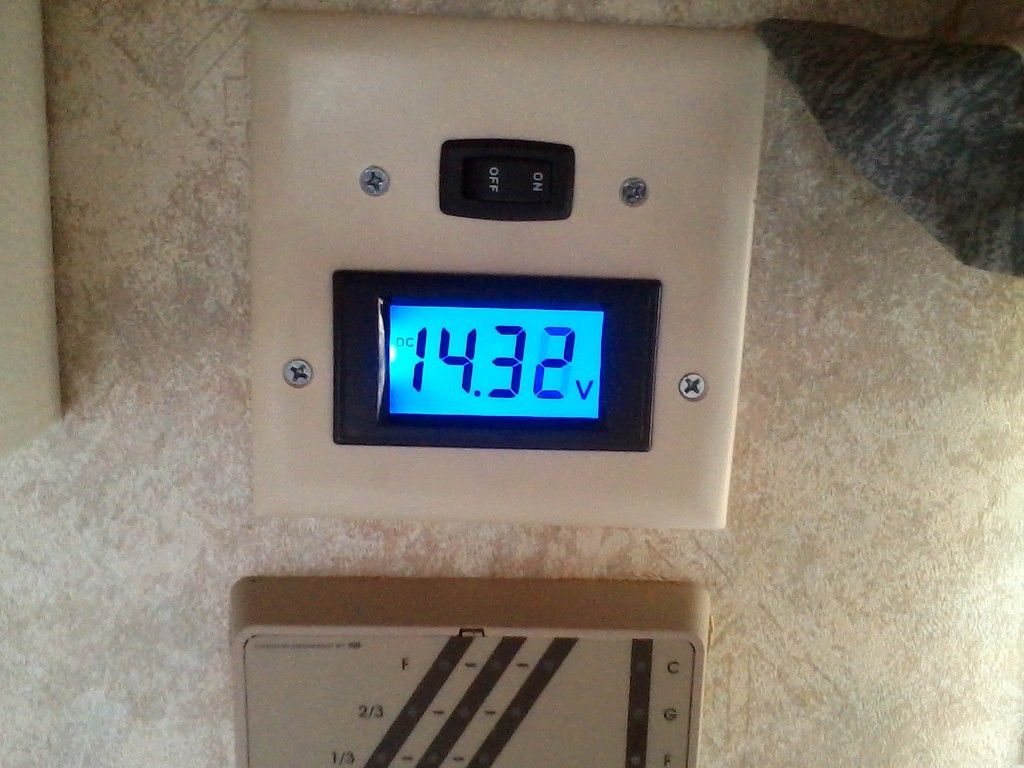
And this is at the batterys.. 14.47 volts from my alternator... Cant get any better then this.. IMO I should be able to recharge my batterys when boondocking in a few hours...
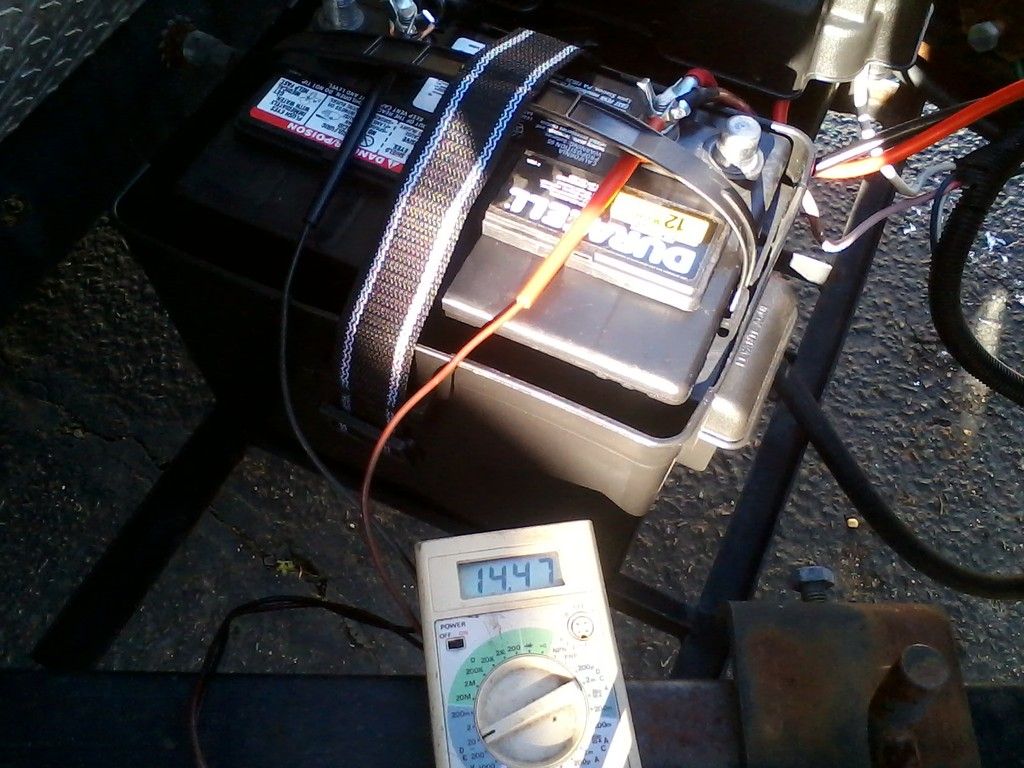
Any one what to share what I can do better or criticism let me know please...
Hope this helps others that may want to try this mod...
Again I will get amp readings soon...
2006 Silverado ext cab long bed. 3:42 rear. LM7 5.3 motor. 300 hp 350 ft lbs torgue @ 4000 rpms
2018 coachmen Catalina sbx 261bh
- Mark as New
- Bookmark
- Subscribe
- Mute
- Subscribe to RSS Feed
- Permalink
- Report Inappropriate Content
Apr-20-2015 05:31 PM
4/21/2015 update:
Had to move the camper today so did a recheck, batts were at 90% or 12.77volts, cranked the truck put in tow/haul and lights on at idle. Again 15.5 volts into the isolator with 14.8 volts out and 50 amps to the cranking battery. Once this tapered off isolator switched output to trailer batts and had 14 amps to the trailer batteries. Refrig was off and with the trailer closed up there is no way to measure the voltage at the batteries. Another minor mod in the works maybe.
Remote breaker box at the camper

Under hood breaker box and battery isolator

Very noisy generator :M
2016 Wrangler JK dinghy
“They who would give up essential Liberty, to purchase a little temporary Safety, deserve neither Liberty nor Safety.” Benjamin Franklin
- Mark as New
- Bookmark
- Subscribe
- Mute
- Subscribe to RSS Feed
- Permalink
- Report Inappropriate Content
Mar-31-2015 11:04 AM
I'd look at using an Andersen connector securely fastened in a fixed location. out of the way with a dust cover on it to keep the grime out. I use them as a main battery disconnect on our camper, and have been quite happy with them. They also provide a quick means of powering other 'stuff' from the camper if needed. I've considered using a similar setup to yours in a pinch if necessary, but I personally wouldn't make it my primary means of charging. It's just plain inefficient, and if I needed to do it more than a couple times a year, I'd be looking at a genset.
- Mark as New
- Bookmark
- Subscribe
- Mute
- Subscribe to RSS Feed
- Permalink
- Report Inappropriate Content
Mar-30-2015 03:09 PM
bandit86 wrote:
I thought of this for when im driving, but for boondocking I want a generator. Most generators, say a 2000 watt Honda only put out 8-10 amps dc,
That is an unregulated connection. Why would you consider using it? You would just cook the batterys.
so get a large and I mean large 50 amp battery charger and run it off the generator. I have seen the 200/40/20/2 die hard battery chargers designed to start a dead car bit never had a chance to see at what voltage they charge at. one of those would be almost perfect if one could limit charging voltage to 14.5
Well you can buy your 1000 buck gen and the car charger and test it and let us know .. I did my set up for less then 60 bucks.
Always wondered why generators aren't made a hogh current 14.5 volt output, but then one can build one of these;
http://www.energymatters.com.au/honda-12v-25hp-55amp-battery-charger-with-digital-ampmeter-p-273.html
Why build one? And how much is that? All it is , is an alternator with a honda motor driving it..
I already have one. Its a 4.3 liter vortec V6 with a 105 amp alt...
EDited, if you have a generator all you need is a small welding unit that does dc, or a mig welder. To the whip need to add a large capacitor to clean out the rectified ac into a good dc, then a solar controller to limit output to something a battery can take.
Dont want to weld, most rv converters can do very high currents, about 50 amps dc, its basically a 12v power supply. 150 bucks. Wire into generator and hook all dc outputs to the battery. Probably easiest fix, no need to reinvent the wheel. Maybe even tap into your rv converter you already have, and using a breaker give full dc power to the bbatteries
Sounds complicated. Ill stick with my set up. Thanks for the feedback, but it dont help much IMO...
2006 Silverado ext cab long bed. 3:42 rear. LM7 5.3 motor. 300 hp 350 ft lbs torgue @ 4000 rpms
2018 coachmen Catalina sbx 261bh
- Mark as New
- Bookmark
- Subscribe
- Mute
- Subscribe to RSS Feed
- Permalink
- Report Inappropriate Content
Mar-30-2015 05:01 AM
Always wondered why generators aren't made a hogh current 14.5 volt output, but then one can build one of these;
http://www.energymatters.com.au/honda-12v-25hp-55amp-battery-charger-with-digital-ampmeter-p-273.html
EDited, if you have a generator all you need is a small welding unit that does dc, or a mig welder. To the whip need to add a large capacitor to clean out the rectified ac into a good dc, then a solar controller to limit output to something a battery can take.
Dont want to weld, most rv converters can do very high currents, about 50 amps dc, its basically a 12v power supply. 150 bucks. Wire into generator and hook all dc outputs to the battery. Probably easiest fix, no need to reinvent the wheel. Maybe even tap into your rv converter you already have, and using a breaker give full dc power to the bbatteries
- Mark as New
- Bookmark
- Subscribe
- Mute
- Subscribe to RSS Feed
- Permalink
- Report Inappropriate Content
Mar-29-2015 10:48 AM
pianotuna wrote:
Hi,
Thanks for the data. It is quite amazing how fast the amps going into the battery bank drop off.
Fully charged for me is when there is less than one amp going into the bank.
You may want to improve the wiring on the house bank to be like the image below.
Yes I do have the house bank wired like that with all 6 gauge...
2006 Silverado ext cab long bed. 3:42 rear. LM7 5.3 motor. 300 hp 350 ft lbs torgue @ 4000 rpms
2018 coachmen Catalina sbx 261bh
- Mark as New
- Bookmark
- Subscribe
- Mute
- Subscribe to RSS Feed
- Permalink
- Report Inappropriate Content
Mar-29-2015 10:41 AM
Thanks for the data. It is quite amazing how fast the amps going into the battery bank drop off.
Fully charged for me is when there is less than one amp going into the bank.
You may want to improve the wiring on the house bank to be like the image below.

My ride is a 28 foot Class C, 256 watts solar, 556 amp-hours of Telcom jars, 3000 watt Magnum hybrid inverter, Sola Basic Autoformer, Microair Easy Start.
- Mark as New
- Bookmark
- Subscribe
- Mute
- Subscribe to RSS Feed
- Permalink
- Report Inappropriate Content
Mar-29-2015 09:54 AM
To power the truck and a fully charged truck battery required about 2 amps from the alternator.
I drained camper batterys down to 12.3 volts
5pm start
amps 57
volts at camper batterys 13.99
alt temp 148f
5:20
amps 22.4
volts at camper batterys 13.93
alt temp 188f
5:40
amps 19.5
volts at camper batterys 14.05
alt temp 187f
6:00
amps 13.4
volts at camper batterys 14.02
alt temp 176f
6:20
amps 11.3
volts at camper batterys 14.09
alt temp 171f
6:40
amps 8
volts at camper batterys 14.20
alt temp 159f
7:00
amps 5.8
volts at camper batterys 14.22
alt temp 160f
7:20
amps 4.9
volts at camper batterys 14.33
alt temp 155f
7:40
amps 4
volts at camper batterys 14.34
alt temp 154f
Note: I could have probably stopped here as batterys were most likely charged.
8:00
amps 3.2
volts at camper batterys 14.34
alt temp 154f
9:00
amps 2.7
volts at camper batterys 14.39
alt temp 154f
9:10
After running the furnace for 10 minutes to take off the surface charge, I took a final volt reading.
12.85 volts at battery.
In summary without using amp meter or anything else when camping I will charge until volts get up to the 14.3 mark and stop there more or less... This will be with my volt meter I have in the camper..
Although I always carry my multimeter with me and the hydrometer...
2006 Silverado ext cab long bed. 3:42 rear. LM7 5.3 motor. 300 hp 350 ft lbs torgue @ 4000 rpms
2018 coachmen Catalina sbx 261bh
- Mark as New
- Bookmark
- Subscribe
- Mute
- Subscribe to RSS Feed
- Permalink
- Report Inappropriate Content
Mar-29-2015 08:23 AM
pianotuna wrote:
Hi,
Thanks for posting the information gathered from your test.
It is normal for a 50 amp breaker to NOT open immediately when the rating is exceeded. My wiring is rated for 60 amps, so when I replaced the fuses with breakers I used 50 amp ones.
Did you happen to measure the voltage at the alternator and voltage at the house batteries just after beginning the testing?
I'd love to see the every twenty minutes data in a table.
I will put something together later or tomorrow.
I think volts at alt and battery would be similar to what I was reading at the campers batterys as 6 gauge wire would have no loss @ 12 ft of cable IMO..
2006 Silverado ext cab long bed. 3:42 rear. LM7 5.3 motor. 300 hp 350 ft lbs torgue @ 4000 rpms
2018 coachmen Catalina sbx 261bh
- Mark as New
- Bookmark
- Subscribe
- Mute
- Subscribe to RSS Feed
- Permalink
- Report Inappropriate Content
Mar-29-2015 07:26 AM
Thanks for posting the information gathered from your test.
It is normal for a 50 amp breaker to NOT open immediately when the rating is exceeded. My wiring is rated for 60 amps, so when I replaced the fuses with breakers I used 50 amp ones.
Did you happen to measure the voltage at the alternator and voltage at the house batteries just after beginning the testing?
I'd love to see the every twenty minutes data in a table.
My ride is a 28 foot Class C, 256 watts solar, 556 amp-hours of Telcom jars, 3000 watt Magnum hybrid inverter, Sola Basic Autoformer, Microair Easy Start.
- Mark as New
- Bookmark
- Subscribe
- Mute
- Subscribe to RSS Feed
- Permalink
- Report Inappropriate Content
Mar-29-2015 06:46 AM
lawrosa wrote:
Also a note. These are two new battery's.. I found it very hard to kill them throughout the day. I had every light on in the camper, fan for oven vent on, tv on through invertor, and heater on.
I also have an 7 pin plug with a fuse that connects the two pins togther so I can sit with the campers running lights on.
Basically I was pulling about 7 amps. It would of taken 10 hours to kill the batterys...
I guess what I am saying is I dont have enough hi draw items to kill the batterys quickly...
I hope this helps the people out there that may want to try this themselves.. I urge you all to make sure you fuse both ends of the cables. If not bad bad things can happen...
Let me know if there are any questions I can answer with anything I missed...
Excellent report. Thank you. Like I say, we have been doing it for years and it works excleently for us. Ours is on a V10 ford based class C motorhome but execution is almost the same. We had to use longer cables so the gauge is thicker but same idea. I have no place to pack a generator or the fuel for it. As far as noise from the v10, I guarantee our v10 is quieter than any generator of any make. I can hear a 2800 onan start from the other end of a campground. I can't hear my v10 in the next camp site.
Life is not measured by the number of breaths we take but rather by the moments that take our breath away.
- Mark as New
- Bookmark
- Subscribe
- Mute
- Subscribe to RSS Feed
- Permalink
- Report Inappropriate Content
Mar-29-2015 06:40 AM
I also have an 7 pin plug with a fuse that connects the two pins togther so I can sit with the campers running lights on.
Basically I was pulling about 7 amps. It would of taken 10 hours to kill the batterys...
I guess what I am saying is I dont have enough hi draw items to kill the batterys quickly...
I hope this helps the people out there that may want to try this themselves.. I urge you all to make sure you fuse both ends of the cables. If not bad bad things can happen...
Let me know if there are any questions I can answer with anything I missed...
2006 Silverado ext cab long bed. 3:42 rear. LM7 5.3 motor. 300 hp 350 ft lbs torgue @ 4000 rpms
2018 coachmen Catalina sbx 261bh
- Mark as New
- Bookmark
- Subscribe
- Mute
- Subscribe to RSS Feed
- Permalink
- Report Inappropriate Content
Mar-29-2015 06:28 AM
And if I used 2 gallons of gas or 4 gallons or whatever idling, then so be it. Lets say 4 gallons which is the high side IMO it would cost me 8 bucks worth of gas...
The hottest the alternator got was 188f. This is fairly cool for an alternator as it normally is in the 160f range anyway according to my temperature testing.. And this was after the first 20 minutes. After that is went down from there..
I assume even from my testing there will be some naysayers out there that may debuke my claims...
How can I improve upon this?
If and when this alternator goes I will replace with the 145 amp ad244 that directly fits gm applications with the cs130d 105 amp alt as I have..
The ad244 has better diode placement and cooling abilities.
Temp at 20 minute mark..The highest it read..
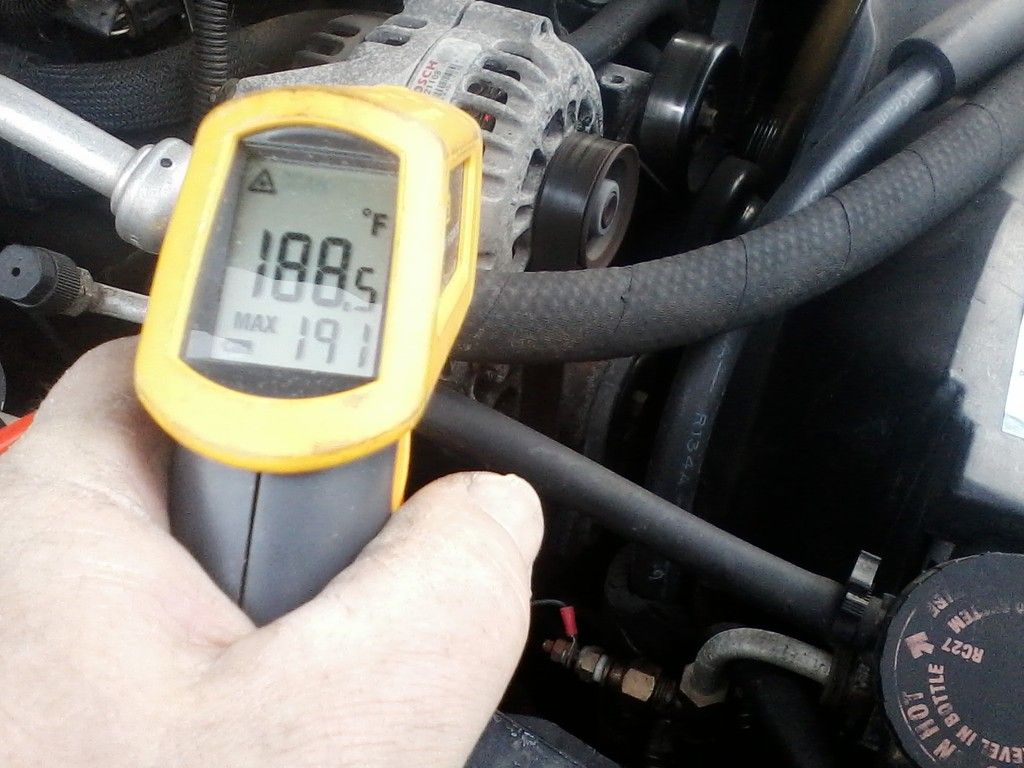
Here is the link/vid showing the cs130d vs the ad244 alternators gm produced...
cs 130d vs ad244 alternators
2006 Silverado ext cab long bed. 3:42 rear. LM7 5.3 motor. 300 hp 350 ft lbs torgue @ 4000 rpms
2018 coachmen Catalina sbx 261bh
- Mark as New
- Bookmark
- Subscribe
- Mute
- Subscribe to RSS Feed
- Permalink
- Report Inappropriate Content
Mar-29-2015 06:26 AM
Life is not measured by the number of breaths we take but rather by the moments that take our breath away.
- Mark as New
- Bookmark
- Subscribe
- Mute
- Subscribe to RSS Feed
- Permalink
- Report Inappropriate Content
Mar-29-2015 06:04 AM
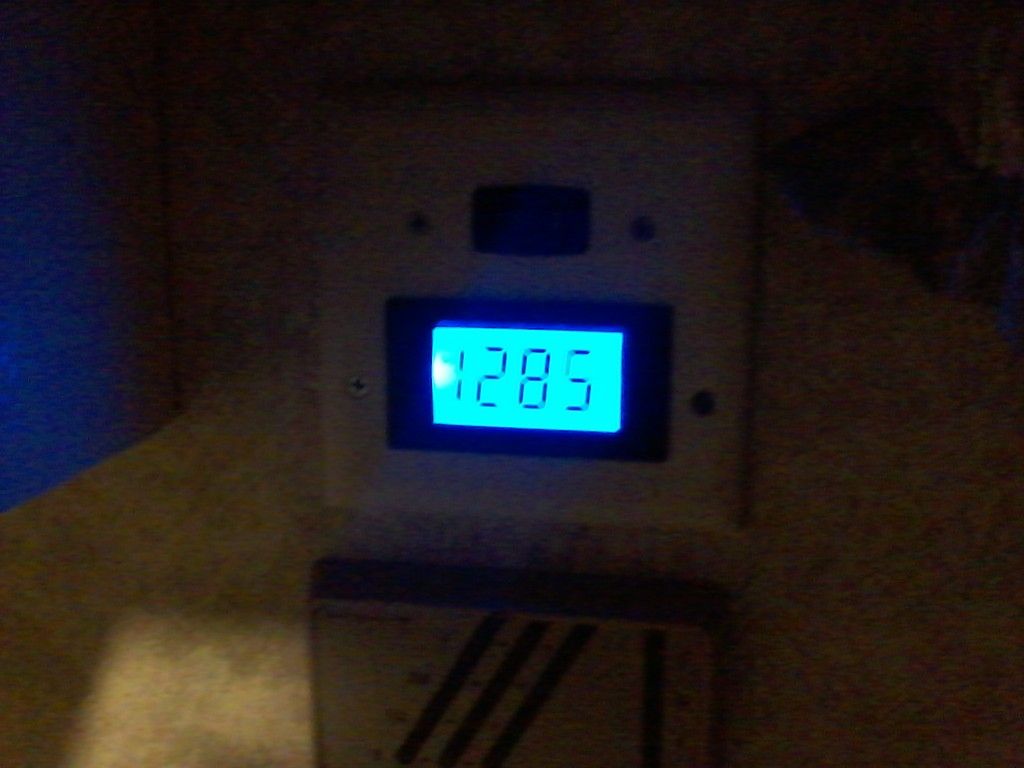
2006 Silverado ext cab long bed. 3:42 rear. LM7 5.3 motor. 300 hp 350 ft lbs torgue @ 4000 rpms
2018 coachmen Catalina sbx 261bh





